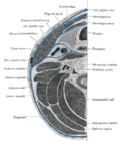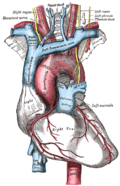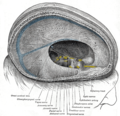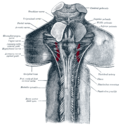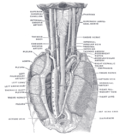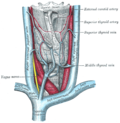Vagus nerve






The vagus nerve is the tenth cranial nerve (CN X) and is a critical component of the autonomic nervous system. It is responsible for a wide range of functions, including heart rate regulation, gastrointestinal peristalsis, sweating, and muscle movements in the mouth, including speech. The vagus nerve is the longest of the cranial nerves, extending from the brainstem to the abdomen.
Anatomy[edit]
The vagus nerve originates in the medulla oblongata of the brainstem. It exits the skull through the jugular foramen and travels down the neck within the carotid sheath, alongside the internal carotid artery and the internal jugular vein.
Branches[edit]
The vagus nerve has several branches, including:
- The auricular branch, which supplies sensation to the ear.
- The pharyngeal branch, which innervates the muscles of the pharynx.
- The superior laryngeal nerve, which innervates the cricothyroid muscle.
- The recurrent laryngeal nerve, which innervates the intrinsic muscles of the larynx.
Function[edit]
The vagus nerve is involved in parasympathetic control of the heart, lungs, and digestive tract. It slows the heart rate, stimulates digestive secretions, and regulates the contraction of smooth muscles in the gastrointestinal tract.
Clinical Significance[edit]
Damage to the vagus nerve can result in a variety of symptoms, including difficulty swallowing, loss of voice, and abnormal heart rate. Vagus nerve stimulation is a treatment used for epilepsy and depression.
Related Pages[edit]
References[edit]
- Standring, S. (2016). Gray's Anatomy: The Anatomical Basis of Clinical Practice. 41st Edition. Elsevier.
- Netter, F. H. (2014). Atlas of Human Anatomy. 6th Edition. Saunders.
Gallery[edit]
-
Vagus nerve and its branches.
-
Vagus nerve in the thorax.
-
Vagus nerve in the abdomen.
-
Vagus nerve and the heart.
-
Vagus nerve and the stomach.
-
Vagus nerve and the intestines.
-
Vagus nerve and the liver.
-
Vagus nerve and the lungs.
-
Vagus nerve and the esophagus.
-
Vagus nerve and the pharynx.
-
Vagus nerve and the larynx.
-
Vagus nerve and the ear.
-
Vagus nerve and the carotid artery.
-
Internal carotid artery, near the vagus nerve.
| The cranial nerves | ||||||||||
|---|---|---|---|---|---|---|---|---|---|---|
|
Ad. Transform your life with W8MD's Budget GLP-1 injections from $75


W8MD offers a medical weight loss program to lose weight in Philadelphia. Our physician-supervised medical weight loss provides:
- Weight loss injections in NYC (generic and brand names):
- Zepbound / Mounjaro, Wegovy / Ozempic, Saxenda
- Most insurances accepted or discounted self-pay rates. We will obtain insurance prior authorizations if needed.
- Generic GLP1 weight loss injections from $75 for the starting dose.
- Also offer prescription weight loss medications including Phentermine, Qsymia, Diethylpropion, Contrave etc.
NYC weight loss doctor appointmentsNYC weight loss doctor appointments
Start your NYC weight loss journey today at our NYC medical weight loss and Philadelphia medical weight loss clinics.
- Call 718-946-5500 to lose weight in NYC or for medical weight loss in Philadelphia 215-676-2334.
- Tags:NYC medical weight loss, Philadelphia lose weight Zepbound NYC, Budget GLP1 weight loss injections, Wegovy Philadelphia, Wegovy NYC, Philadelphia medical weight loss, Brookly weight loss and Wegovy NYC
|
WikiMD's Wellness Encyclopedia |
| Let Food Be Thy Medicine Medicine Thy Food - Hippocrates |
Medical Disclaimer: WikiMD is not a substitute for professional medical advice. The information on WikiMD is provided as an information resource only, may be incorrect, outdated or misleading, and is not to be used or relied on for any diagnostic or treatment purposes. Please consult your health care provider before making any healthcare decisions or for guidance about a specific medical condition. WikiMD expressly disclaims responsibility, and shall have no liability, for any damages, loss, injury, or liability whatsoever suffered as a result of your reliance on the information contained in this site. By visiting this site you agree to the foregoing terms and conditions, which may from time to time be changed or supplemented by WikiMD. If you do not agree to the foregoing terms and conditions, you should not enter or use this site. See full disclaimer.
Credits:Most images are courtesy of Wikimedia commons, and templates, categories Wikipedia, licensed under CC BY SA or similar.
Translate this page: - East Asian
中文,
日本,
한국어,
South Asian
हिन्दी,
தமிழ்,
తెలుగు,
Urdu,
ಕನ್ನಡ,
Southeast Asian
Indonesian,
Vietnamese,
Thai,
မြန်မာဘာသာ,
বাংলা
European
español,
Deutsch,
français,
Greek,
português do Brasil,
polski,
română,
русский,
Nederlands,
norsk,
svenska,
suomi,
Italian
Middle Eastern & African
عربى,
Turkish,
Persian,
Hebrew,
Afrikaans,
isiZulu,
Kiswahili,
Other
Bulgarian,
Hungarian,
Czech,
Swedish,
മലയാളം,
मराठी,
ਪੰਜਾਬੀ,
ગુજરાતી,
Portuguese,
Ukrainian
